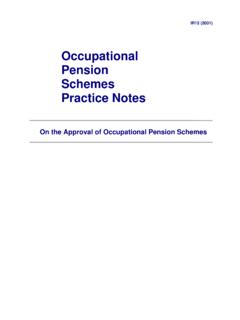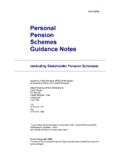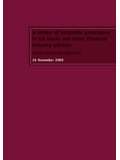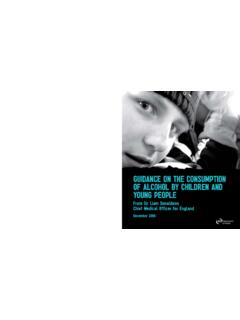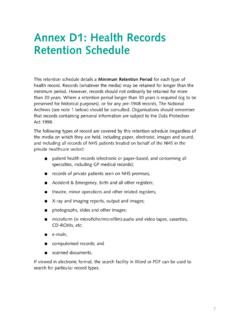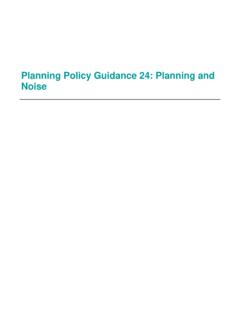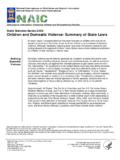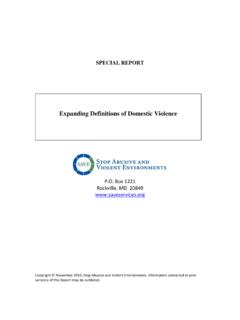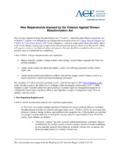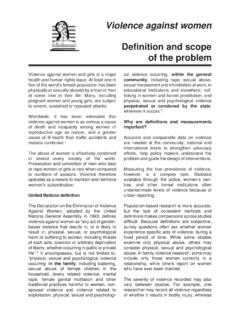Transcription of DOMESTIC VIOLENCE: LITERATURE REVIEW
1 DOMESTIC violence : A LITERATURE REVIEW Mary Barnish September 2004 HM Inspectorate of Probation Second Floor Ashley House 2 Monck Street London SW1P 2BQ Tel: 020 7035 2203 Fax: 020 7035 2237 Email: Contents Introduction p5 PART ONE: WHAT DO WE KNOW ABOUT DOMESTIC violence ? The contents page has hyperlinks to each chapter. Please click heading to be taken to chosen page. At the end of each section, there is a link to take you back to this page. 1. What do we mean by DOMESTIC violence ? Defining DOMESTIC violence p6 The nature of DOMESTIC violence p6 2. The extent of DOMESTIC violence Measuring DOMESTIC violence p8 Findings from community surveys p9 Men and women s experiences of DOMESTIC violence p12 Victim diversity and DOMESTIC violence p14 Visible and invisible DOMESTIC violence p15 DOMESTIC violence prevalence amongst offenders p17 3.
2 Explaining DOMESTIC violence Theories of DOMESTIC violence p19 Integrated perspectives p20 4. The dynamics of DOMESTIC violence Patterns of DOMESTIC violence p22 Differences between DOMESTIC violence perpetrators and other men p23 How abusive men account for and respond to their violence p24 5. Factors associated with vulnerability to victimisation Demographic factors p27 Situational factors p28 Personal and historical factors p30 6. Factors investigated as risk markers for DOMESTIC violence perpetration Understanding risk markers p32 Demographic factors p33 Previous abuse and criminality factors p35 Attitudinal and cultural factors p35 Dynamic factors p37 Personal and historical factors p39 Key risk markers p46 7. Types of DOMESTIC violence perpetrator Overview of perpetrator typologies p48 Implications of typology research p51 8.
3 The harm done to women by DOMESTIC violence Physical health consequences p54 Mental health consequences p55 The adverse impact of psychological abuse, stalking and secondary victimisation p56 9. Women s responses to DOMESTIC violence Processes of surviving a violent relationship p58 Why women stay, leave or return to violent relationships p59 Help seeking p30 Understanding women s use of the criminal justice system 10. DOMESTIC violence and children The co-occurrence of DOMESTIC violence and child abuse p64 The nature, extent and impact of children s exposure to DOMESTIC violence p65 2 PART TWO: WHAT DO WE KNOW ABOUT DOMESTIC violence INTERVENTIONS?
4 11. Assessing risk Establishing DOMESTIC violence history p68 The value of women s risk predictions p68 Risk assessment approaches and instruments p69 12. Arrest, prosecution and sentencing Impact of police intervention p73 Impact of prosecution and prosecution policies - p74 Patterns of arrest, prosecution and sentencing in the UK p76 Accounting for attrition and decision-making in DOMESTIC violence cases p77 13. The justice system and community controls Restraining/protection orders p81 Community supervision - p82 14. DOMESTIC violence perpetrator programmes Programme models p85 Programme structure p86 Programme delivery arrangements p86 Intervention standards and guidelines p86 15. Issues in evaluating the effectiveness of perpetrator programmes Study design p89 definition and measurement of programme effectiveness p90 Study participants p91 Programme delivery and context p92 16.
5 Do perpetrator programmes work? Studies without a non-programme comparison group p94 Quasi-experimental studies using comparison groups p96 Randomised experiments p96 UK research on programme effectiveness p98 Overall estimates of programme impact on revictimisation p99 Studies that explore whether one model of intervention is better than another p100 Other considerations in evaluating interventions with perpetrators p101 17. Other interventions with DOMESTIC violence perpetrators Alcohol and drug interventions p104 Couples and family relationship interventions p105 Individual DOMESTIC violence programmes p107 Anger management interventions p107 18. Co-ordinated community interventions The North American experience p109 The UK experience p111 Inter-agency DOMESTIC violence fora p112 19.
6 Meeting the needs of victims/survivors Victims/survivors views of services p114 Health needs and services p115 Victim contact work in the UK Probation Service p116 Crisis intervention, outreach and advocacy services p116 Women s safety services linked to perpetrator programmes p118 Good practice in safety planning p119 Other services p120 20. Protecting and assisting children affected by DOMESTIC violence Current provision and practice p122 Good practice in protecting and assisting children and families p123 321. Enhancing the effectiveness of DOMESTIC violence interventions Attending to the cultural and racial diversity of perpetrators p124 Addressing programme attrition p125 Developing positive working relationships with and between perpetrators p126 Matching perpetrators and interventions p127 Delivering risk-focused interventions p128 Enhancing intervention systems - p129 Learning from preventable tragedies p133 Further research p134 REFERENCES: Pages 135 - 147 4 Introduction This LITERATURE REVIEW was prepared to accompany the HMIP thematic inspection of probation supervision of DOMESTIC violence perpetrators.
7 Alongside the inspection report it aims to contribute to the development of effective probation and wider criminal justice practice in reducing DOMESTIC violence by enhancing knowledge, understanding and awareness of the experiences of victims/survivors, the behaviour of perpetrators, the extent of the harm done by DOMESTIC violence , and the effectiveness of interventions to reduce it. In line with the inspection remit, the REVIEW focuses on DOMESTIC violence perpetrated against partners and ex-partners. It also concentrates largely on male to female violence , consonant with the evidence concerning predominant abuse trends. Whilst the REVIEW occasionally touches on policy and legal frameworks and wider community responses, its main focus is on the issues which should inform criminal justice practice and the themes most salient for the probation service in working to increase the safety of women and children affected by DOMESTIC violence and in holding perpetrators accountable for their actions.
8 The REVIEW should be of direct interest and relevance to both probation managers and practitioners seeking to promote, shape and accomplish informed and effective service delivery to DOMESTIC violence victims/survivors and perpetrators. It should also assist managers to develop and co-ordinate intra-and inter-organisational policies and strategies designed to improve staff awareness and to identify and systematically address DOMESTIC violence . Evidence contained in the REVIEW can be used in staff guidelines, briefings and training. The first part of the REVIEW outlines key research findings on the extent and dynamics of DOMESTIC violence , explanatory theories, perpetrator types, factors associated with vulnerability to victimisation, risk markers for perpetration, the harm done to women and children, women s responses to DOMESTIC violence , and the links with child abuse.
9 The second part of the REVIEW presents evidence on criminal justice responses in particular, and their effects on victims and perpetrators, including arrest, prosecution and sentencing, community controls, perpetrator programmes, co-ordinated community responses, assistance to victims/survivors, child protection, and enhancement of intervention effectiveness. This REVIEW was developed by identifying recent relevant research and REVIEW papers through online searches of the ASSIA (Applied Social Sciences Index and Abstracts) NCJRS (National Criminal Justice Reference Service) and PsycINFO abstracts databases and other governmental, academic and independent DOMESTIC violence information sources, and by following up key referenced texts. Particular attention has been paid to available UK research. However, much of the published LITERATURE on DOMESTIC violence is North American in origin.
10 Thanks are extended to Di Askwith and Alan MacDonald at HMI Probation for their advice and assistance in structuring and editing this REVIEW . Thanks also to Jean Hartington for proofreading and to Zach Rathore for the format and production. Contents 5 PART ONE: WHAT DO WE KNOW ABOUT DOMESTIC violence ? 1. What do we mean by DOMESTIC violence ? Defining DOMESTIC violence Definitions of DOMESTIC violence are socially constructed, have developed over time, and reflect prevailing understandings, interests and power distributions (Muehlenhard & Kimes 1999). Feminist understandings shaped by the lived experiences of abused women and by supporting research evidence, have helped to expand conceptualisations of DOMESTIC violence as physically injurious assault by highlighting the interrelated range of abusive, coercive, controlling behaviours causing psychological, sexual or physical harm, which often accompany or precede the use or threat of physical force.


